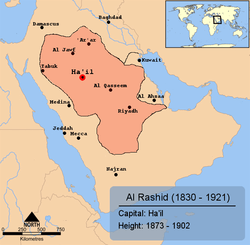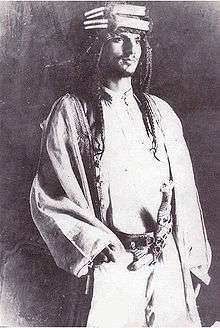Rashidi dynasty
| House of Rashid | |
|---|---|
| Country | Emirate of Jabal Shammar |
| Parent house | Shammar Tribe |
| Titles | Emir of Jabal Shammar |
| Founded | 1836 |
| Founder | Abdullah bin Rashid |
| Final ruler | Muhammad bin Talal |
| Dissolution | 1921 in Ha'il (Conquest of Ha'il) |


Al Rasheed, the House of Rashid, or the House of Rasheed (Arabic: آل رشيد Āl Rashīd; pronounced [ʔæːl raˈʃiːd]) were a historic Arabian House or dynasty that existed in the Arabian Peninsula between 1836 and 1921, rulers of the Emirate of Jabal Shammar and the most formidable enemies of the House of Saud, rulers of the Emirate of Nejd. They were centered in Ha'il, a city in northern Nejd that derived its wealth from being on the route of the Hajj pilgrimage and was a city known for its trading, which absorbed many of the travelers that were bound to Mecca. The rulers of Ha'il were the sons of Abdullah bin Rashid, founder of the dynasty.
History
The Al Rasheed derived their name from their forebear Abdullah ibn Rasheed. The first "amir" (Prince) Abdullah Ibn Rasheed was the first to begin the establishment of the Emirate of Ha'il. The Rasheedi amirs cooperated closely with the Ottoman Empire. However, this cooperation became problematic as the Ottoman empire lost popularity.
In 1890, Al Rasheed occupied Riyadh. Then they defeated Al Sauds and forced them to go into exile, first in Bahrain, next to Qatar and finally to Kuwait.[1]
As with many Arab ruling dynasties, the lack of a generally accepted rule of succession was a recurrent problem with the Rasheedi rule. The internal dispute normally centered on whether succession to the position of amir should be horizontal (i.e. to a brother) or vertical (to a son). These internal divisions within the family led to bloody infighting. In the last years of the nineteenth century six Rasheedi leaders died violently. Nevertheless, The Al Rasheed Family still ruled and fought together in the Saudi–Rashidi Wars.
During the first twenty years of the 20th century the Arabian Peninsula saw a long-running series of wars as the Saudis and their allies sought to unite the peninsula under their rule. While the Al Rasheed rallied the majority of other tribes to their side the effort proved futile, and by 1921 Ha'il was captured by Ibn Saud. Ibn Saud had the upper hand and the support of the majority of central Arabian tribes.
Some members of the Rasheed family left the country and went into voluntary exile, mostly to Iraq. By the 1990s only a handful were still outside Saudi Arabia.
Amirs of the House of Rasheed

- ʿAbdullah bin Rashīd (Arabic: عبدالله بن رشيد), (1836–48). Abdullah came to power after he got the support from Imam Faisal bin Turki bin Abdullah Al Saud to be assigned officially and takeover the Emirate of Hail instead of the current Emir, Muhammad bin Ali al-Jaafar al-Shammari. Abdullah bin Rashid came to the picture after leading a revolt (together with his brother prince ʿUbayd Al Rashīd) against the ruler of Ha'il, Muhammad bin Ali, who was a fellow member of the Jaafar al-Shammari lineage. As a leader, Abdullah was praised for bringing peace and stability both to Ha'il and to the surrounding region. Abdullah demanded from his brother prince ʿUbayd an ahd (covenant) according to which succession to the office of amir would remain in Abdullah's line. Where it was supported by their cousin and close friend Zamil Bin Sabhan from Al Sabhan Family who supported both brothers for the succession.
- Talāl bin ʿAbdullah (Arabic: طلال بن عبدالله), (1848–68). The son of Abdullah. Talal is remembered for his relative liberalism and interest in building projects. During his rule, the Barzan Palace in Ha'il was completed. He established regular trade connections with Iraq, and expanded the Rashidi sphere of influence:
"The inhabitants of Kaseem, weary of Wahhabee tyranny, turned their eyes towards Telal, who had already given a generous and inviolable asylum to the numerous political exiles of that district. Secret negotiations took place, and at a favourable moment the entire uplands of that province—after a fashion not indeed peculiar to Arabia—annexed themselves to the kingdom of Shommer by universal and unanimous suffrage." (William Gifford Palgrave, 1865: 129.)
Talal was considered relatively tolerant towards foreigners, including traders in Ha'il:"Many of these traders belonged to the Shia sect, hated by some Sunni, doubly hated by the Wahabees. But Telal [sic] affected not to perceive their religious discrepansies, and silenced all murmurs by marks of special favour towards these very dissenters, and also by the advantages which their presence was not long in procuring for the town". (William Gifford Palgrave 1865: 130.)
In the 1860s, internal disputes in the House of Saud allowed a Rashidi/Ottoman alliance to oust them. The Rashidi occupied the Saudi capital of Riyadh in 1865 and forced the leaders of the House of Saud into exile. Talal later died in a shooting incident which has been termed "mysterious". Charles Doughty, in his book Travels in Arabia Deserta, writes that Talal committed suicide. Talal left seven sons, but the oldest, Bandar, was only 18 or 20 when his father died. - Mutʿib bin ʿAbdullah (Arabic: متعب بن عبدالله), (1868–9). A younger brother of Talal, he was supported by senior members of the Rashid family and the sheikhs of the Shammar sections. After only a year, he was shot and killed in the Barzan Palace by his nephew and next amir, Bandar. Doughty's version of the events is that Bandar and Badr, the second-oldest son, cast a silver bullet to kill their uncle because they knew he wore an amulet that protected him against lead.
- Bandar bin Talāl (Arabic: بندر بن طلال), (1869). Ruled for only a short time before he was killed by his uncle, Muhammed, the brother of Mutʿib. Bandar reportedly married his uncle's widow and had a son by her.
- Muhammed bin ʿAbdullah (Arabic: محمد بن عبدالله), (1869–97) A confrontation outside Ha'il with his nephew, the young Amir Bandar, ended with Muhammed killing Bandar. Muhammed then continued his journey to Ha'il and announced himself as the new amir. In order to prevent the possibility of revenge, Muhammed gave orders for the execution of all of Bandar's brothers (the sons of Talal), Bandar's cousins (the children of Talal's sister), and their slaves and servants. Only one of Talal's sons, Naif, survived. Additionally he eliminated the threat around him from "his uncle" Ubaid and his sons, while he relied on the far cousins Al Sabhan family who identified as supporter for his father before himself. In spite of the inauspicious beginning, his rule turned out to be the longest in the history of the Rashidi dynasty. His rule became "a period of stability, expansion and prosperity" (ref.: p. 61, Al Rasheed). His expansion reached al-Jawf and Palmyra to the north, and Tayma and Khaybar to the west. In 1891, after a rebellion, ʿAbd al-Rahman bin Faysal bin Turki Al Saud left Riyadh. The Saud family, including the ten-year-old Ibn Saud, went into exile in Kuwait.
- ʿAbd al-ʿAzīz bin Mutʿib (Arabic: عبدالعزيز بن متعب), (1897–1906). A son of Mutʿib, the third amir, he was adopted by his uncle Muhammed, the fifth amir, and brought up to be his heir. After Muhammed died of natural causes, Abd al-ʿAziz succeeded him unopposed. However Rashidi rule was insecure as their Ottoman allies were unpopular and weakening. In 1904, the young Ibn Saud, the future founder of Saudi Arabia, returned from exile with a small force and retook Riyadh. Abd al-ʿAziz died in the battle of Rawdat Muhanna with ibn Saud in 1906.
- Mutʿib bin ʿAbd al-ʿAzīz (Arabic: متعب بن عبدالعزيز), (1906–07). Succeeded his father as amir. However, he was not able to win support of the whole family, and, within a year, he was killed by Sultan bin Hammud.
- Sultān bin Hammūd (Arabic: سلطان بن حمود), (1907–08). A grandson of Ubayd (the brother of the first amir), he was criticized because he ignored the ahd (covenant) between his grandfather and the first amir. He was unsuccessful in fighting Ibn Saud, and was killed by his own brothers.
- Saʿūd bin Hammūd (Arabic: سعود بن حمود), (1908–10). Another grandson of Ubayd. Saʿud was killed by the maternal relatives of Saʿud bin ʿAbd al-ʿAziz, the 10th amir.
 Saud bin Abdul Aziz Rashid
Saud bin Abdul Aziz Rashid - Saʿūd bin ʿAbd al-ʿAzīz (Arabic: سعود بن عبدالعزيز), (1910–20). A boy of 10 when he was made Amir, his maternal relatives of the Al Sabhan family ruled as regents on his behalf until he came of age, based on the constitution of Emara. In 1920, he was assassinated by his cousin, Abdullah bin Talal (a brother of the 12th amir). Two of his widows remarried: Norah bint Hammud Al Sabhan became Ibn Saud's eight wife, and Fahda bint Asi Al Shuraim of the Abde section of the Shammar tribe became Ibn Saud's ninth wife and the mother of King Abdullah of Saudi Arabia.
- ʿAbdullah bin Mutʿib (Arabic: عبدالله بن متعب), (1920–21). A son of the 7th amir, he surrendered to Ibn Saud, he was 20 years old.Despite of that, he was one of the key factor of Hail Emara deterioration.
- Muhammad bin Talāl (Arabic: محمد بن طلال), (1921). A grandson of Naif, the only surviving son of Talal, the 2nd Amir. Muhammad bin Talal's wife Nura bint Sabhan from the Al Sabhan family married to King Abdulaziz after he was imprisoned by him.[2] Surrendered to Ibn Saud. One of the daughters of Muhammad bin Talal, Watfa, married Prince Musa'id bin Abdulaziz Al Saud, the twelfth son of Ibn Saud. Prince Musa'id and Watfa became the parents of Prince Faisal bin Musa'id, the assassin of King Faisal.[2]
There has been a tendency to attribute the development of the House of Rasheed to trading and commercial expansion, but documents have come to light which emphasise the significance of external pressures and the Rashidi's interaction with foreign governments and leaders, but Al Sauds are equally said of the same thing which catapulted them to power.[3]
See also
References
- ↑ McHale, T. R. (Autumn 1980). "A Prospect of Saudi Arabia". International Affairs (Royal Institute of International Affairs 1944-). 56 (4): 622–647. JSTOR 2618170.
- 1 2 Al Rasheed, Madawi (1991). Politics in an Arabian Oasis. The Rashidis of Saudi Arabia. New York: I. B. Tauirs & Co. Ltd.
- ↑ Blomsbury Auctions, London
Further reading
Many foreign travellers visited the Rashidi amirs at Ha'il and described their impressions in journals and books, including:
- Georg Wallin (1854): Narrative of a Journey from Cairo to Medina and Mecca, by Suez, Arabia, Tawila, al-Jauf, Jublae, Hail and Negd in 1845, Journal of the Royal Geographical Society, vol 24: 115-201. (Reprinted in Travels in Arabia, New York: Oleander Press, 1979.)
- William Gifford Palgrave (1865): Personal Narrative of a Year's Journey through Central and Eastern Arabia (1862-1863), vol. I, Macmillan & Co., London,
- Lady Anne Blunt (1881): A Pilgrimage to Nejd, The Cradle of the Arab Race: a Visit to the Court of the Arab Emir and `our Persian Campaign` (reprinted 1968)
- Charles Montagu Doughty (1888): Travels in Arabia Deserta. (Reprinted many times)
- Gertrude Bell (1907): The Desert and the Sown (republished 1987)
- D. G. Hogarth (1905): The Penetration of Arabia: a Record of Western Knowledge Concerning the Arabian Peninsula.
- Freeth, Zahra, and Winstone, H.V.F.: Explorers of Arabia from the Renaissance to the End of the Victorian Era, Allen & Unwin, London, 1978
External links
- Al Rasheed on hukam.net, with pictures and flags. (Arabic)
